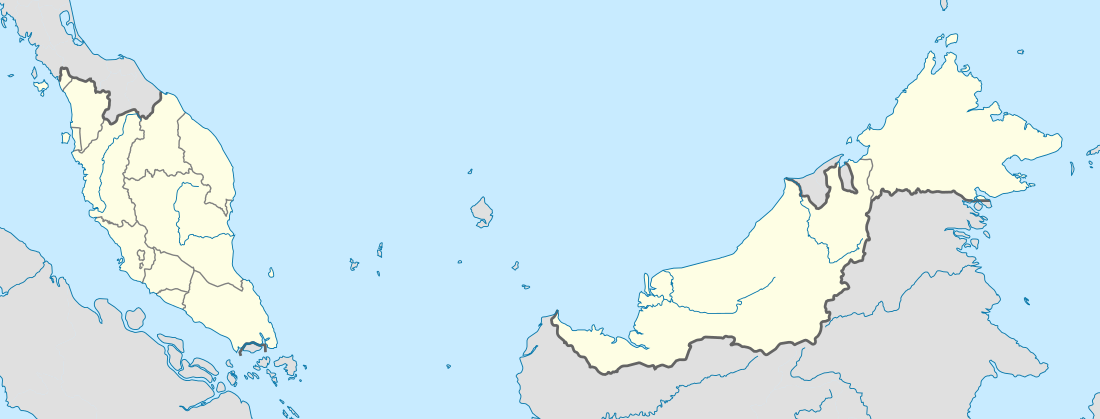Kuala Kangsar District
| Kuala Kangsar District كوالا كڠسر | |||
|---|---|---|---|
 | |||
| |||
 Kuala Kangsar District | |||
| Coordinates: 4°46′N 100°56′E / 4.767°N 100.933°ECoordinates: 4°46′N 100°56′E / 4.767°N 100.933°E | |||
| Country | Malaysia | ||
| State | Perak | ||
| District | Kuala Kangsar | ||
| Government | |||
| • Type | Municipality | ||
| • Mayor | Shafie Arifin | ||
| Area | |||
| • Total | 204.94 km2 (79.13 sq mi) | ||
| Population (2000) | |||
| • Total | 39,300 | ||
| • Density | 752/km2 (1,950/sq mi) | ||
| Flower | Canna Generalis | ||
| Website | www.mpkkpk.gov.my | ||
The Kuala Kangsar District (population 39,300) is a district and the royal town of Perak, Malaysia, located at the downstream of Kangsar River, where it flows into the Perak River. It is the main town in the administrative district of Kuala Kangsar.
History
The site must have had a strange effect on Sultan Yusuf Sharifuddin Mudzaffar Shah of Perak who ruled from 1877 to 1887. Unlike many rulers who protected their royal palaces and strongholds by selecting their vantage points carefully where they could detect enemy approach from afar, the Sultan had his first royal palace built beside the riverbank. He then named it 'Istana Sri Sayong'.
Apart from being exposed to the impending threat of invasion, the other problem was the force of monsoon seasons, which led to numerous flooding as water gushed down from the jungles above through the many tributaries. The name Kuala Kangsar is believed to be derived from 'Kuala Kurang-Sa', which literally means '100 minus (-) one', usually interpreted as 'the 99th small tributary to flow into the Perak River'.
One flooding was so severe, it almost swept the palace away. Finally, after the Big Flood or Air Bah in 1926, it was decided to move the place further up onto the knoll where stands the current Royal Palace named Istana Iskandariah with its Art-Deco architecture, a rare but significant piece of architectural milestone in Malaysia.
The Sultan of Perak officially resides in Kuala Kangsar, and it has been Perak's royal seat since the 18th century. It is one of four towns that plays a role in Perak's complex succession system. It was the administrative seat of the first British Resident in the Malay Peninsula, James W. W. Birch, from October 1874 until he was murdered on 2 November 1875. It was the capital of Perak until 1876.[1]
Kuala Kangsar is also known in Malaysian history as the site where the first Conference of Rulers, the Durbar, was held in 1897. By the 1890s, the growth of the tin mining towns of Ipoh and Taiping had eclipsed Kuala Kangsar, but it remains to this day one of the most attractive of the Malay royal capitals.
The town is also the site of the first rubber tree planted in Malaysia. The person responsible was the English botanist Henry Nicholas Ridley. He was the one who helped Malaya and eventually Malaysia become the largest rubber producer in the world. The tree still stands today.
The first Malaysian scout troop was established in Kuala Kangsar. Consequently, its squad number is 001.
Geography

Kuala Kangsar is not only a town, but an administrative district too. Kuala Kangsar share its borders with Larut, Matang and Selama at the west, Hulu Perak at the north, Gua Musang (Kelantan) at the east, Kinta at the south, Perak Tengah and Manjung at the southwest.
Administrative divisions
Kuala Kangsar District is divided into 9 mukims, which are:
- Chegar Galah
- Kampung Buaia
- Kota Lama Kanan
- Kota Lama Kiri
- Lubuk Merbau
- Pulau Kamiri
- Saiong
- Senggang
- Sungai Siput
Education
- Madrasah Idrisiah Kuala Kangsar (MADID)
- Malay College Kuala Kangsar (MCKK)
- Clifford Secondary School (Sekolah Menengah Clifford)
Tourist attractions
- Ubudiah Mosque and the Royal Mausoleum
- Istana Kenangan (Old Palace, now the Perak Royal Museum)
- Istana Iskandariah (The Royal Palace)
- Sultan Azlan Shah Gallery
- Victoria Bridge (built 1900)[2]
- Iskandariah Bridge
- Sultan Abdul Jalil Shah Bridge
- Pavilion Square Tower
- Keris Memorial
- Bukit Chandan
- The first & oldest rubber tree planted in the country (near Police Headquarters)
- Handicraft Development Centre, Enggor
- Riverside walk next to the Sayong Bridge
- Public swimming pool at Bukit Chandan
- The morning wet market
- Laksa stalls (Medan Selera Sungai Perak)
- Hot springs (Kolam Air Panas), Ara Panjang, Manong
- Government English Girls School (GEGS, SMK Raja Perempuan Kelsom)
- Clock tower (Jam Besar Kuala Kangsar)
- Ulu Kenas waterfall
Transportation
Two bridges now connect Kuala Kangsar to Sayong. Sultan Abdul Jalil Shah Bridge is made out of concrete and is located near the town while Sultan Iskandar Bridge is farther upstream and is made out of steel. Kuala Kangsar is easily accessible via the North-South Expressway and by train.
Members of Parliament in the district (2008 Elections)
- Datin Mastura Mohd Yazid – Member of Parliament for the constituency of Kuala Kangsar.
- Dato' Seri Mohamed Nazri Abdul Aziz – Member of Parliament for the constituency of Padang Rengas and Minister Tourism & Culture
- Dr. Jeyakumar Devaraj – Member of Parliament for the constituency of Sungai Siput.
Notable People
- Lam Wei Haur (Professor Dr)
See also
References
- ↑ Ben M. Cahoon. WorldStatesmen.org "Malay States" Check
|url=value (help). worldstatesmen.org. Retrieved 7 May 2013. - ↑ Ben van Wijnen. "Karai, The Forgotten Bridge". malaysiasite.nl (in Dutch). Retrieved 7 May 2013.
External links
| Wikimedia Commons has media related to Kuala Kangsar. |
 Kuala Kangsar travel guide from Wikivoyage
Kuala Kangsar travel guide from Wikivoyage

